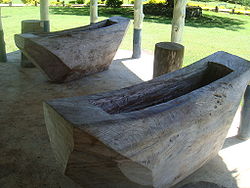

Piula Theological College is a Methodist training institution in Samoa. It was established in 1868 in Lufilufi on the north coast of Upolu island after its initial beginnings in 1859 at Satupa'itea on the south coast of Savai'i island. The Methodist Mission in Samoa purchased the land at the Methodist leaning district and later named their training center Piula Theological College. The name Piula is a transliteration of the biblical name Beulah [1] which means married (to the Lord).
Contents
The college includes the recently renovated historic Piula chapel, large open grounds, and Samoan fale. At the front of the chapel are steps leading down to the sea where Fatumea, the oval Piula Cave Pool is, a popular swimming hole for locals and visitors.



